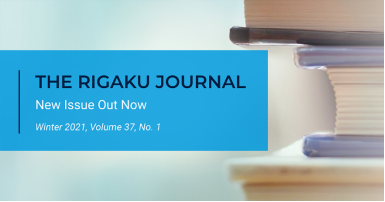The Woodlands, Texas – March 3, 2021 - Rigaku have just published the latest issue of their Journal (Vol 37 #1), continuing a proud tradition of publishing quality research since 1984. The current issue features a range of analytical techniques including X-ray CT, SCXRD, powder XRD and XRF covering a range of applications. The Rigaku Journal is freely available from the Rigaku website.
X-ray Computed Tomography (X-ray CT) is a rapidly growing volumetric imaging technique that allows non-destructive examination of components, revealing internal features and flaws. In the current issue, a practical technique is demonstrated whereby X-ray CT can be used to evaluate the effectiveness of laundry detergents. The technique described could easily be extrapolated to other applications, broadening the appeal of X-ray CT.

Single Crystal X-ray Diffraction (SCXRD) is a powerful tool for molecular structure determination of such things as medicines, aroma chemicals and agrochemicals. However, obtaining quality crystals to analyze can be difficult. A new technique called the Molecular Grabber method, builds on the success of the crystalline sponge method, overcoming tedious and time-consuming trials that still may not result in good crystals.
In the second of a series of articles on powder XRD, Masashi Omori of Rigaku Corporation’s Applications Laboratories considers the importance of hardware configuration for obtaining good quality data. This comprehensive review looks at everything from X-ray sources to optical components, all the way to detectors, making it an excellent reference for any XRD operator.
X-ray Fluorescence (XRF) provides an excellent alternative to ICP-OES and combustion ion chromatography for high-throughput analysis of halogen-containing materials. These materials need to be carefully controlled as they can have adverse effects on production equipment and the environment. The suitability of XRF for this purpose is demonstrated using a series of examples.
In a recent development, the performance and operation of Rigaku’s new HyRES (High-Resolution Receiving Optic) for SmartLab XRDs are demonstrated. These systems simplify and accelerate changes between the standard and the high-resolution optical systems for the characterization of such things as epitaxial thin films with a Hybrid Pixel Array Detector (HPAD).
Micro Area XY XRD mapping can provide valuable information about physical properties such as the state distribution of a substance, the strength distribution of a material or a device and more. These properties can be determined through the integration of an X-Y stage, CBO-µ X-ray optic, HPAD detector and Data Visualization plug-in for Smart Lab Studio II.
The new OIL-MULTI-PAK brings the complex task of analyzing the different elements in the vast variety of oil types into the wheelhouse of even new XRF operators. Quantitative oil analysis is quick and easy using the liquid cell and the supplied package of data media consisting of intensities of standard samples, analytical parameters and drift correction samples.
The Rigaku Journal is unique amongst scientific instrument manufacturers and demonstrates Rigaku’s commitment to research and development. Previous issues containing a wealth of technical information are also freely available through the Rigaku website at www.rigaku.com/downloads/rigaku-journal?source=PressRelease.